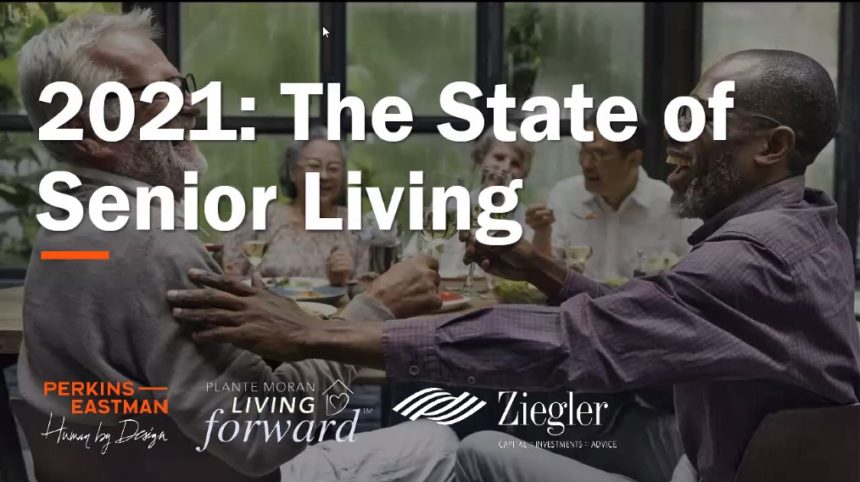
Opportunity called, and it’s time for change.
Tom Meyers, senior managing director of specialty investment bank Ziegler, used that phrase during a “State of Senior Living 2021” webinar Tuesday with representatives from consulting firm Plante Moran and architecture firm Perkins Eastman to characterize the perfect timing for life plan communities to seize on pandemic lessons learned and redefine the future.
Industry resilience
Alexis Denton, associate principal of New York-based Perkins Eastman, shared the results of a 2021 State of the Industry biennial survey released two weeks ago, saying that the main takeaway is that the industry is resilient.
“While there may be conflicting views on the short term health, there is optimism for the industry’s long-term health,” Denton said. The Perkins Eastman survey of C-suite leadership and industry consultants also revealed a consensus that the pandemic will have long-term design effects, including those related to outdoor spaces, culinary, amenities and small group living.
The survey revealed conflicting data on the outlook for the life plan community model. Some signaled that the entry fee model is less attractive, whereas others found that the core tenants of the model — namely, creating community and providing social connections — remain strong.
When it came to nontraditional models, the Perkins Eastman survey found declining interest in urban living, multi-generational living and destination living options, which may mirror current trends associated with leaving dense environments. Interest has increased in models offering the most flexibility in how and where residents access care, including apartments and hybrid independent living / assisted living.
Improvement opportunities
Referencing Plante Moran Living Forward’s COVID-19 Sentiment Report, which surveyed independent living residents and prospects during the height of the pandemic, Dana Wollschlager, national senior living development practice leader, said the results revealed opportunities for improvement.
The survey covered residency, social isolation, safety, staff, communication technology, dining and lifestyle. And although most residents (86%) revealed that they were glad they had moved into a senior living community, and three-fourths said they were really glad to be living in a community during the pandemic, only 47% said communities used technology effectively to allow for engagement and connectivity.
“There needs to be an emphasis and greater focus on technology,” Wollschlager said.
Priorities for the future that emerged from the crisis, she added, focused on strategic planning, asset repositioning opportunities, technology, financial performance and strategic opportunities for growth through mergers, affiliations and acquisitions.
“We’ve grown comfortable with business as usual,” Wollschlager said. “The pandemic rocked our world. I’m afraid we might fall back into old habits. You need to push your organization to think differently, anticipate the unexpected, unlearn old habits, start thinking unconventionally.”
Financial health
Lisa McCracken and Meyers of Ziegler discussed the financial health of the not-for-profit senior living and care sector.
McCracken, director of senior living research and development for Ziegler, said there has been some long-term care sector consolidation, with approximately 54% of transactions being in the form of dispositions to the for-profit sector. Although the pace has accelerated due to COVID-19 pressure, McCracken said not all of these transactions are a result of distress. The not-for-profit sector weathered the COVID-19 storm fairly well, but affiliations, mergers and acquisitions span the continuum, she said.
Ziegler is tracking the emergence of the chief strategy / business development officer role, McCracken said. Organizations that have someone in charge of looking for joint venture and affiliation partnerships, she said, are increasing at a faster pace than those whose CEOs or chief financial officers assume those duties in addition to their main titles.
Those organizations that entered the pandemic in a position of financial strength saw a pre-pandemic operating environment that was “about as good as it could get,” Meyers said. And although government programs helped, those companies with issues going into the pandemic only saw those issues exacerbated, he added.
“Not-for-profit life plan communities fared the best,” Meyers said. “Life plan communities are poised for a spring back and strategic reinvestment.”




